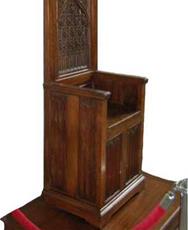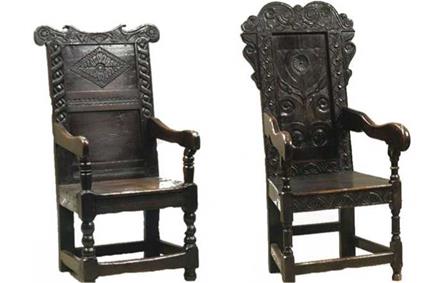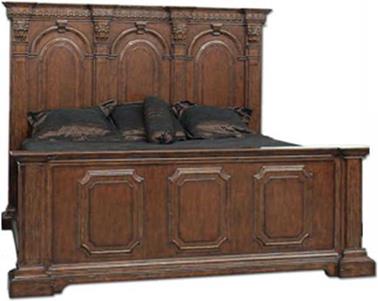A characteristic feature of furniture in the early Middle Ages was the widespread use of wood turning techniques, including for legs, backrests, cases and connectors. Many of these elements referred to the products of Roman artisans in form and style. In the Byzantine period, furniture was incrusted with ivory and lined with rich and soft fabrics. Like the Greeks and Romans, Byzantine carpenters used support legs between which they fitted openwork or board backrests. A symbol of the significant influence of the antiquity on Byzantine work is also the throne of King Dagobert (Fig. 1.20).
In the Romanesque period, the technique of manufacturing furniture deteriorated significantly and came down to simple carpenter works, while for decorating purposes polychromy and coloured paintings on a chalk base were commonly used. At that time, in the north of Europe, furniture was produced mainly from oak wood, while in the south, from coniferous wood. The structures were massive, oversized with large sections of elements, often turned and carved (Fig. 1.21). Next to the chairs with a rectangular seat supported on four legs, three-legged frame structures with triangular seat boards were also made.
Fig. 1.20 The throne of king Dagobert made from gilded bronze, around the seventh century (Department of coins, medals and antiquities, France)
|
1 ‘I |
||
|
-Л |
|
Fig. 1.21 Romanesque armchairs built from massive, turned legs, around the twelfth-thirteenth century |
We know about the constructions of Romanesque beds only from iconography. Based on them, it can be concluded that the furniture in the early Middle Ages differed significantly from antique furniture (Gostwicka 1981, 1987). The main element of the design of the bed is turned or cuboid corner posts tied with cases (Fig. 1.22).
For storage, mainly chests were used which were massive in structure made of thick fir-tree wood or oak boards that formed the side walls and bottom of the chest, the walls were joined using vertical posts. Cabinets, as a substitute for chests, were extremely rare. Their earliest designs come from the thirteenth and fourteenth century. Romanesque cabinets were characterised by smooth, although thick exterior walls, made of wooden, well carved boards.
The Gothic period began a clear breakthrough in European furniture making. In place of the massive and heavy furniture, light frame panel constructions appeared. This resulted in chests, which were hitherto widely used in the Romanesque period, being ousted by cupboards that were innovative in form and functionality, in which the frame elements were joined by mortise and tenon joints. Mostly, they served for storage, and pantries also for displaying expensive dishes and table settings, which testified to the luxury and wealth of the household members.
In the fifteenth century, multi-door cabinets started to be built, which were equipped with numerous lockers, drawers and flaps. These furnishings were placed on a high base with a frame construction with corner supports. Panel elements were usually veneered with precious veneers made of ash wood or maple wood, and in the Alpine countries, the wood of pines, fir trees, spruces, larches, cedar and
|
Fig. 1.22 Romanesque bed from the fourteenth century |
sometimes walnut was used. Thanks to the special design of carving tools, a new ornament was also introduced, commonly used in the Gothic period—it was flat in the shape of scrolls of parchment paper. However, it was difficult to do in coniferous wood; therefore, the plant ornament was used interchangeably. Gothic carpenters used chisels and planes, which made the quality of wood carving, which decorated practically all furniture, more attractive. In addition, artisans used inlay, polychromy and gilding.
Some furniture for storage, in particular chests, which in the Gothic period was encased with backrests and armrests, also began to serve as seats (Fig. 1.23). Examples of such furniture have been preserved mainly in churches in the form of typical stalla.
Among the much distinctive furniture for sitting from this period, the most important is Italian constructions with folding frames, while typical pieces of furniture for lying on were beds of a chest structure with a canopy. Alcove beds were known then, walls of a frame panel structure built up on three sides, as well as curtain beds covered with a textile curtain on four sides. A breakthrough was also enclosing the bottom part of the bed with a chest construction designed for storing bed linen, curtains and heavy canopies.
Significant progress took place also in the group of furniture for work and dining. Tables lost their massive and immutable character to structures with divided and sliding panels, which easily provided a new usable surface. Furniture with

 |
Fig. 1.23 Gothic sitting and storage furniture from around the fifteenth century (Avignon, France)
folding panels, fitted on hinges, also appeared. The tables of wealthy owners were distinguished by carved coats of arms incorporating other ornaments that made the piece of furniture more beautiful (Fig. 1.24).





